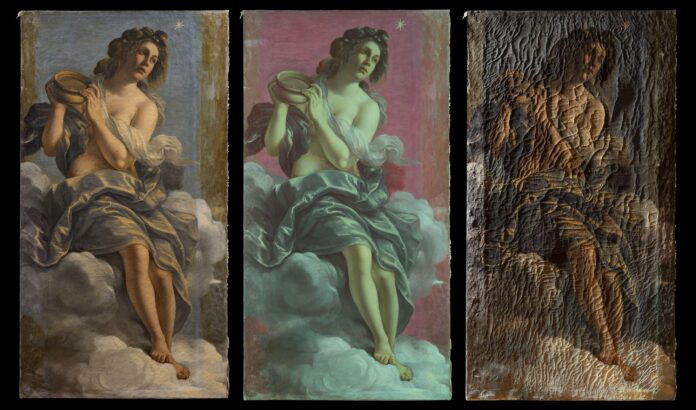An early painting by Artemisia Gentileschi has been removed from the ceiling of the Casa Buonarroti so that experts can study the original work that lies under the canvas’s surface. The restoration of L’Allegoria dell’Inclinazione (1616) is being carried out in public view at the former Florence home of Michelangelo Buonarroti. The findings will be shown in an exhibition at the home-museum from September 2023 to January 2024.

The team preparing for the painting’s descent from ceiling Photo: Olga Makarova; courtesy of Casa Buonarroti and Calliope Arts
The commission by Michelangelo Buonarroti the Younger (1568-1646), the great nephew of the famed artist Michelangelo, is part of a Casa Buonarroti cycle by 15 up-and-coming Tuscan artists glorifying Michelanelo’s genius. It shows a young nude woman, thought to be a self portrait, alongside a star indicating innate artistic ability and a mariner’s compass supposedly representing Galileo, who had recently been declared a heretic. The nude figure was censored with swirling drapery and veils by the artist Baldassare Franceschini around 70 years after the work’s completion, restorers claim.

Art handlers removed the Artemisia work from Casa Buonarroti’s ceiling Photo: Olga Makarova; courtesy of Casa Buonarroti and Calliope Arts
Titled “Artemisia UpClose”, the project, which was presented to members of the press at the Casa Buonarroti on Wednesday, is sponsored by Calliope Arts—a London-based not-for-profit foundation promoting the arts and history from a female perspective, carrying out much of its work in Florence—and the British collector Christian Levett. It also foresees the refurbishment of parts of the Casa Buonarroti, including the introduction of a new lighting system.

Artemisia (top right) was one of 15 up-and-coming Tuscan artists invited to paint s part of the Casa Buonarroti ceiling cycle with images glorifying Michelanelo’s genius Photo: Olga Makarova; courtesy of Casa Buonarroti and Calliope Arts
In an interview with The Art Newspaper, Wayne McArdle and Margie MacKinnon, co-founders of Calliope, declined to reveal the project’s budget, but said that the funding model is geared towards “leaving something behind” at the museum.
Elizabeth Wicks, the conservator leading the study, has been restoring the work during museum opening hours since October, with visitors invited to ask her questions in what is an “open” and “interactive” process, Casa Buonarroti’s president Cristina Acidini told journalists. Wicks says that removing the repaints could damage the original painting below so state-of-the-art technology—including infrared, reflectography, digital microscopy, X-rays and multispectral imaging—is being used to map the hidden painting.

Conservator Elizabeth Wicks at work on the painting Photo: Olga Makarova; courtesy of Casa Buonarroti and Calliope Arts
The study, which is scheduled to be completed in April, will reveal the condition of the original painting, as well as providing insights into Gentileschi’s method and the kinds of pigments she used. A digital image of the hidden work will be shown in the final exhibition, after the painting is reintroduced into the ceiling cycle. “What made Gentileschi so good? Why was she better than her competitors? These are some of the questions we want to address,” said MacKinnon.

A detail of the cracking on the painting Photo: Olga Makarova; courtesy of Casa Buonarroti and Calliope Arts
Initial restoration work had already offered two surprises, Wicks said. Removing the painting from the ceiling, where it had been partially covered by wooden paneling, revealed that it is 23cm wider and 6cm taller than previously thought. Furthermore, early studies suggest a previous restoration took place, probably in the 1960s. Documents confirming the hypothesis are yet to be found, Wicks said.
Michelangelo the Younger transformed the Casa Buonarroti into the world’s first home-museum, as well as a meeting place for members of the Accademia delle Arti del Disegno, an elite club of artists and intellectuals. The first woman to be admitted to the Accademia, Gentileschi was pregnant when she was commissioned to paint L’inclinazione. She was paid three times more than her male colleagues who contributed works to the cycle.

























